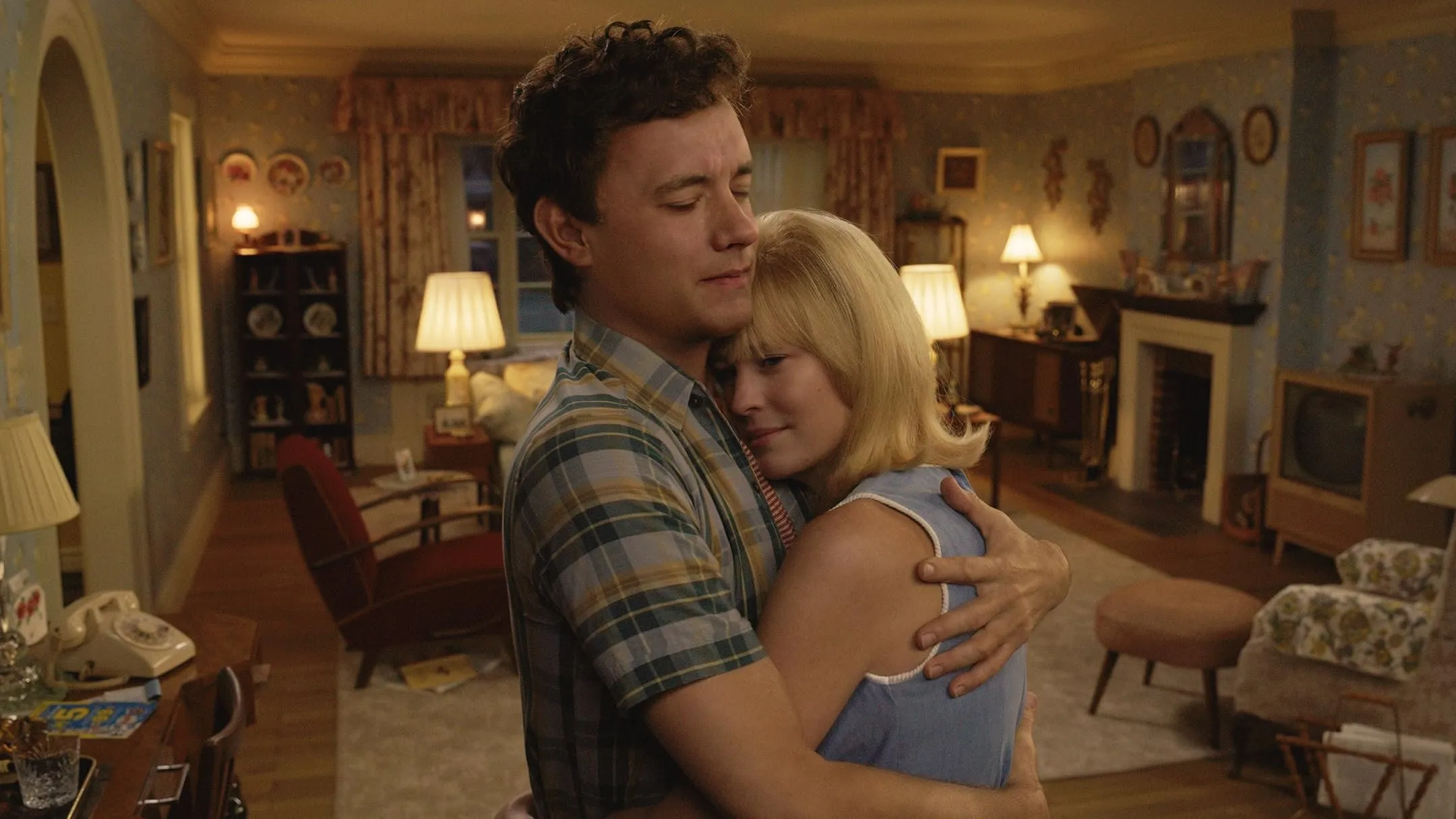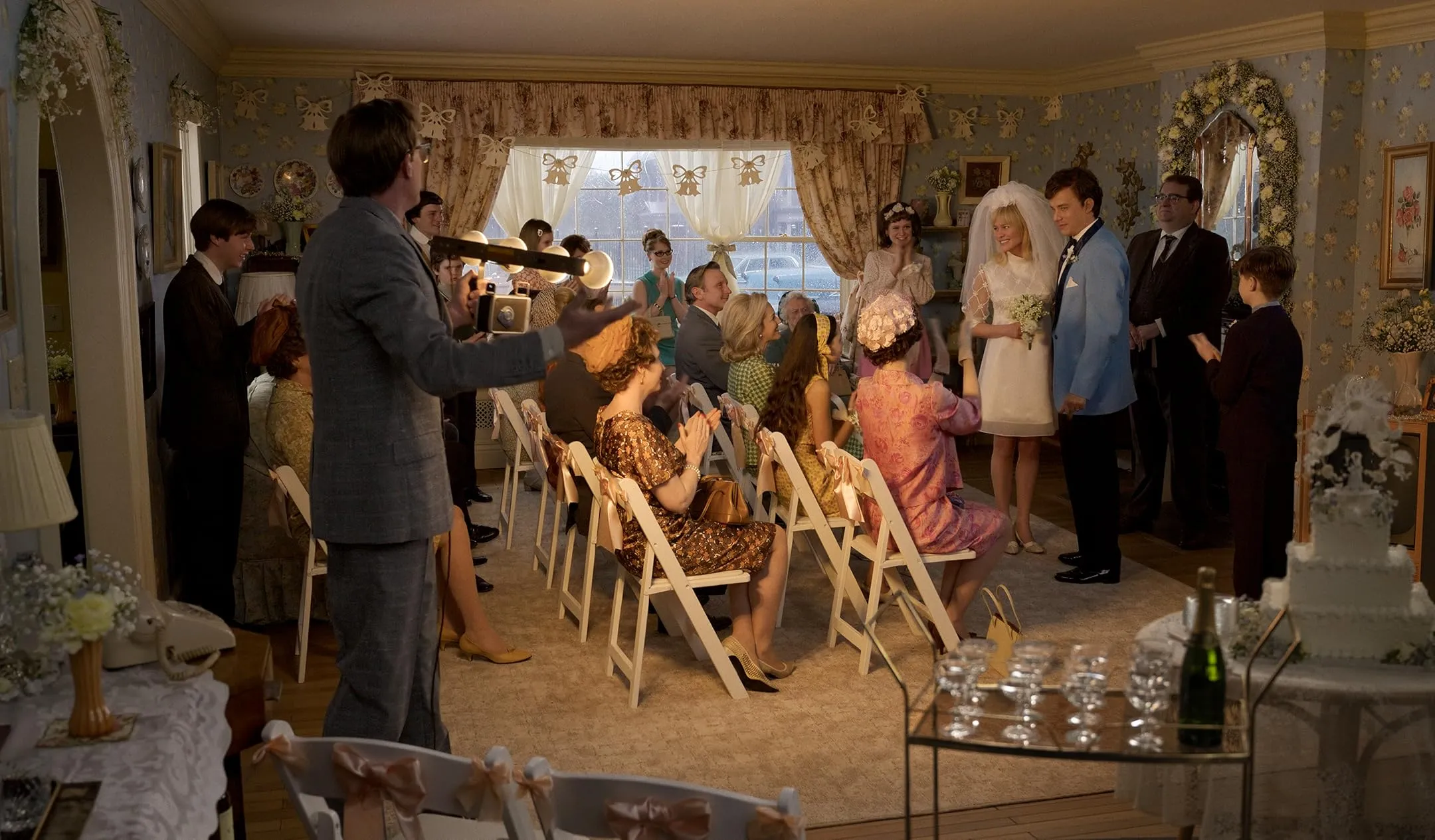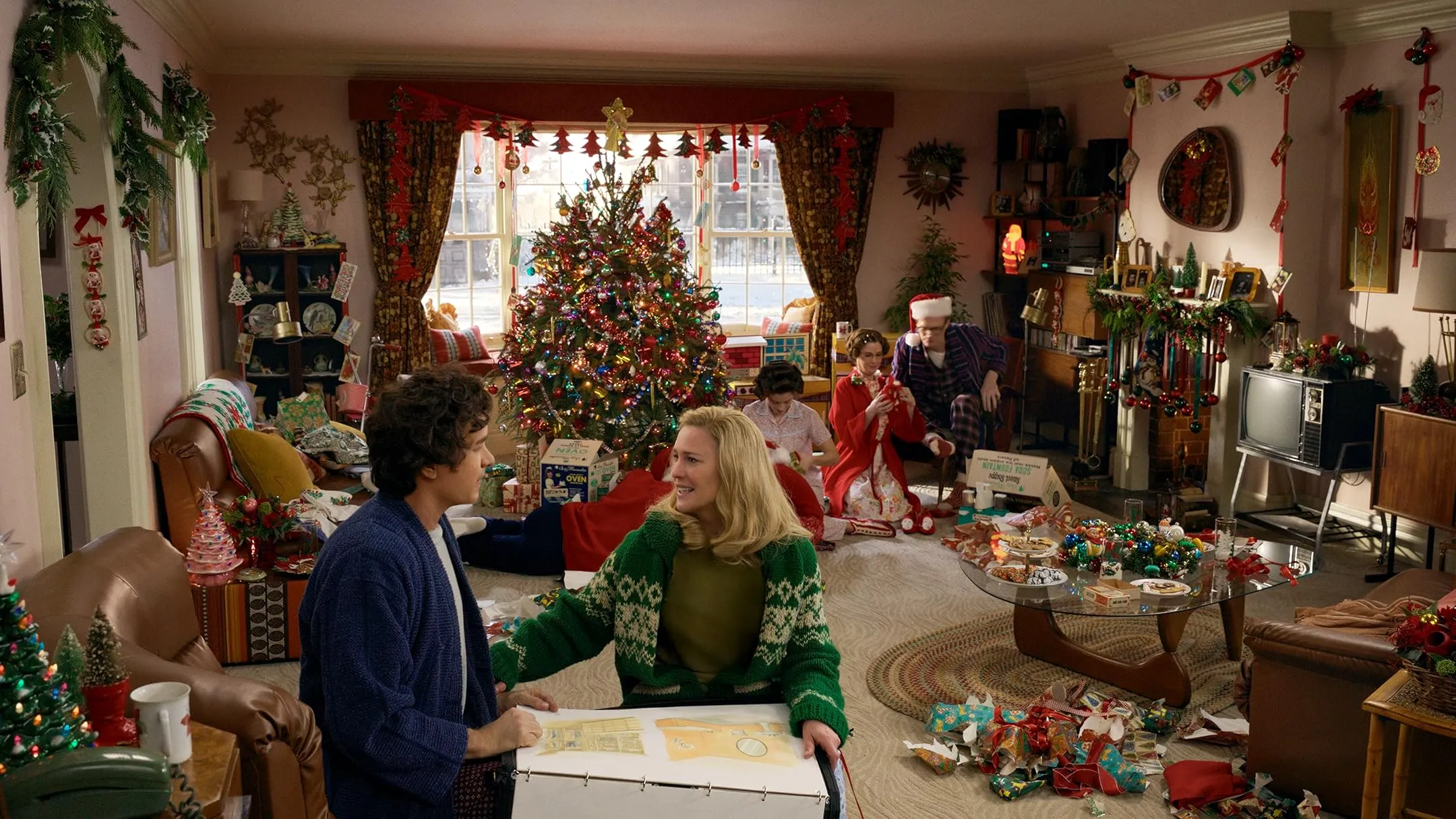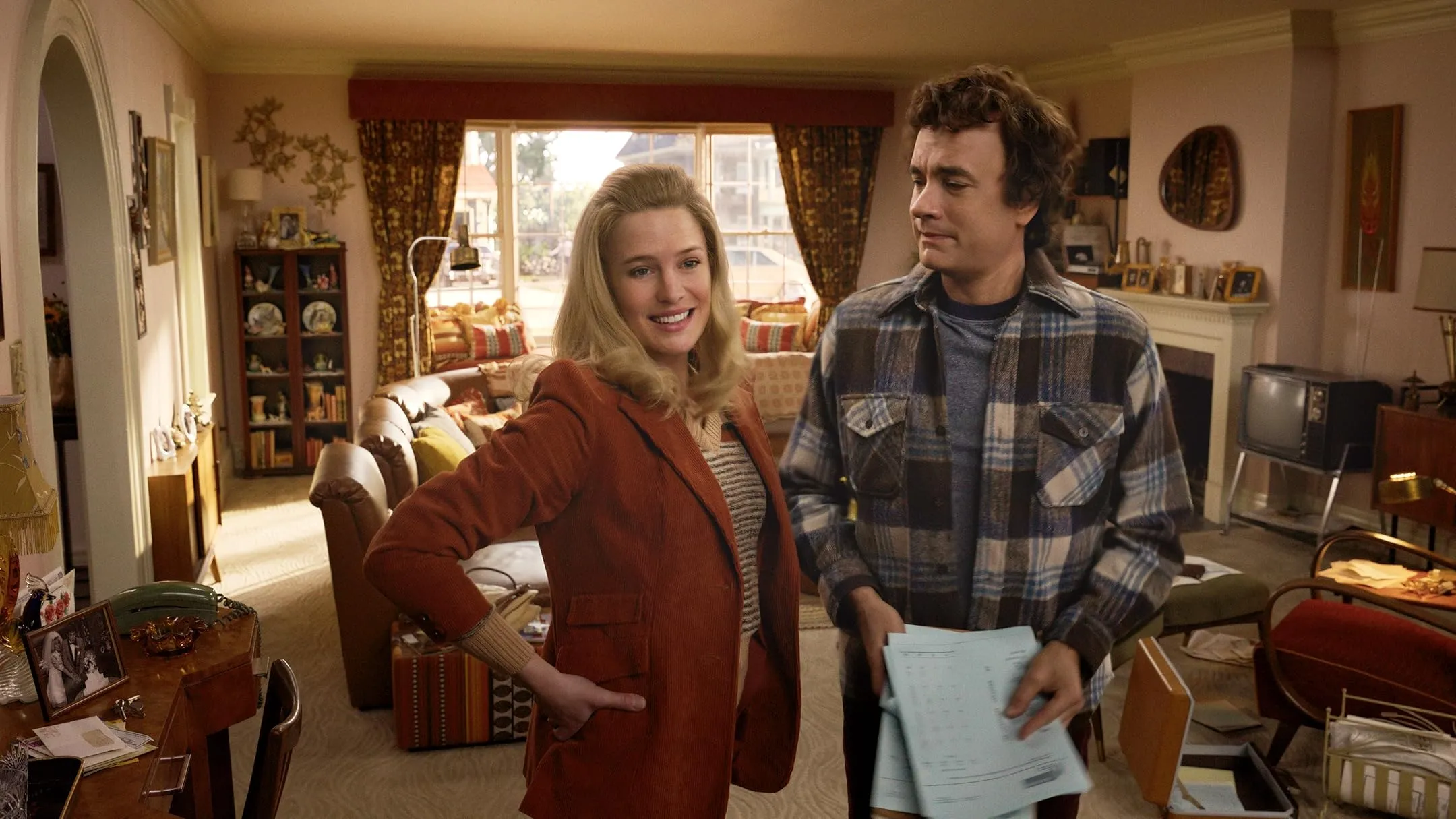Robert Zemeckis takes viewers on an ambitious time-spanning journey with his film Here. Adapting from Richard McGuire’s graphic novel of the same name, the movie traces centuries of history through a single fixed perspective—the eye of a camera planted in a Pennsylvania living room. Steeped in nostalgia yet unafraid to unpack complex ideas, Here captures life’s fleeting nature by lingering in one place across generations.
Anchored by Tom Hanks and Robin Wright, reprising their roles from Forrest Gump under Zemeckis’ direction, the film centers on the Young family, who inhabit the house throughout the 20th century.
Flashing between eras, we see Indigenous peoples, revolutionary figures like Benjamin Franklin, and families in different decades—all connected to this space. Hanks and Wright play Richard and Margaret, whose romance and marriage are observed against a backdrop of wider changes.
Zemeckis takes daring technical swings with his framing of overlapping timelines and de-aging of stars decades younger. If sometimes wistful to a fault, he elevates individual scenes with compassion. The piece honors our human impulse to find collective familiarity across divides of history. Wright shines, conveying Margaret’s frustration within constraints, while Hanks keeps earnest despite the limitations of his digitally crafted youth.
Here invites reflection on life’s enduring patterns through a singular yet sweepingly ambitous scope. With artistry and heart, Zemeckis transforms one location into a vessel, tracing our shared story.
Reframing Perspectives
Here takes a daring formal approach, shooting the entire film from a single static camera angle anchored in a Pennsylvania living room. This allows the movie to portray sweeping spans of history confined to a small space. Frames placed within the frame showcase different eras simultaneously, much like the graphic novel splits panels. At times this conceit immerses the audience as passive observers; other times it restricts creativity.
The static camera peers through generations, from prehistoric creatures to modern families. Within this frame, movable panels present weddings, holidays, arguments—lives overlapping across centuries in the same location. Transitions between smooth, fading visuals of unique time periods streamline the switching narrative.
While comics exploit gaps between panels, film offers a continuous view. Yet this device sparks imagination by implying more exists off-camera. However, the locked perspective risks turning the film into a theatrical performance versus a cinematic experience. More camera movement may have balanced restricted angles with creative visual storytelling.
Digital de-aging faces typical challenges making stars physically match faces from decades prior. But efforts to render Hanks and Wright youthful allow emotive scenes transcending constraints. Subtler makeup or wigs on set perhaps offered a compromise respecting actors while embracing fantasy.
Details like realistic cakes prevent distractions, but the painter character’s singular muse echoes issues only interpreting limited perspectives. Greater world-building may have offset confined viewpoints.
Overall, Here takes bold swings, framing history through a narrow lens. Successes arise from thoughtful adaptations; shortcomings emerge from a form struggling against its very framework. But ambitious concepts that bring compelling stories to new realms deserve praise for expanding artistic boundaries.
Peering Through Windows to the Soul
At the core of Here lie Richard and Margaret, brought to life through nuanced turns from Hanks and Wright. Their challenges embody the film’s aging decades over a lifetime compressed into moments. Yet their connection feels authentic, a testament to actors tapping vulnerability despite constraints.
Wright especially shines, conveying Margaret’s constrained spirit and frictions with stifling tradition. Hanks keeps earnestness amid limitations, relaying a dreamer reined by reality. Supporting them, Bettany breathes fire into a shattered soldier, while Reilly’s steadfast compass tempers his waves of wrath.
Briefly glimpsed characters risk remaining enigmas. But Dockery and Lovibond enrich divergent women of changing eras. Subtler than theatrical flair, they etch souls through subtle gestures.
Fast forwarding between key frames risks preventing immersion. But in linger moments, cracks in the facade emerge, revealing inner landscapes. Here observation yields understanding as characters’ core arcs spotlight life’s recurrent refrains despite shifting backdrops.
By peering through windows to the emotional, Zemeckis and company ensure these temporal travelers remain humankind beneath the surface, their journeys resonating across divisions of time.
Echoes of Time
Here contemplates life’s persistent rhythms through generations living in one place. Central are the imprints of time’s flow and regrets stemming from paths not taken.
The Youngs’ cycles of birth, aging, and death recurring over a century mirror our collective human journey. Characters mirror their forebears, like Richard mirroring his father’s stagnation. Yet moments of beauty emerge as the Indigenous couple finds love across eras.
A contemplative tone invites reflection on history’s themes. But brief gestures risk superficiality, minimizing weightier topics like racism for plot devices. Political currents feel props versus integral to families’ windings.
Deeper dives into characters may have offset this, lent gravitas matching the film’s grand timeline. As is, some struggle to transcend surface, lacking dimensionality to resonate across divides.
Still, Here taps life’s bigger questions through microcosms of individual everydayness. If gracefully acknowledging complexity exceeds current capacities, its ambition deserves applause—and may inspire future works to explore universal truths with increased nuance.
Measuring Moments Across Millennia
Weaving generations into a tidy runtime posed no small task for Here. Lifespans flashed by in snippets, glimpses of larger tales left wandering. Disconnecting cuts jarred against the film’s desires to immerse deeply in each moment across the ages.
Yet within restrictions, signs of care surfaced. Transition frames flowed seamlessly, situating audiences with grace in new places and times. Lingering shots savored simple beauty, like lovers dancing through history or children laughing as seasons turned, transcending snippets into memory.
But rigid fixtures blurred story and character, faces lacking facets to embrace in fleeting scenes. Narration drifted from lives to history lessons, details diluted by racing timelines.
Pacing pinch may stem from fidelity to source instead of form—comics indulge imagination between panels, while film risks disengaging disconnected watches. Loosening shackles possibly unleashed potential for grandeur matched to ambitions.
Still, ambition deserves praise where many play it safe. Here swung for fences, half successes hinting at triumphs if elevating emotion above execution in future works exploring eternity in minutes. Some dreams spring large, time alone proving if they’ve flown.
A Case of Fidelity Over Fantasy
As an adaptation, troubles emerge from Here’s rigid adherence to its source. Where the graphic novel indulges the imagination between panels, the film’s restrictive literalism loses nuanced implications.
Scenes playing out like the comic’s frames capture its perspectives across time. But it fights against its own fluidity to mimic the pages’ structures at the cost of cinematic spirit. A looser interpretation potentially unleashes creative spirit, better marrying means to message.
Yet the work honors central themes, depicting eternal patterns glimpsed across generations within a place. In replicating the novel’s sense of history compressed into a room, it taps something cerebral.
If separating from its predecessor more, Here may soar stylistically. But immense technical feats and ambitious scopes endure despite stumbles. As an original, wrinkles emerge from self-imposed restrictions rather than lack of vision.
Overall raising weighty topics, its transformative swings onto new fronts deserve respect wherever they land. Freed from duty to literalisms, future projects likely indulge their fullest creative command.
A Vision Worth Remembering
Here grapples with grand artistic ambitions, seeking to fuse visual innovations with introspection on life’s deeper puzzles. In moments, it succeeds beautifully—fleeting scenes linger with depth and grace. Yet constraints of form prevent full fruition, hindering character moments and narrative flow.
Still, one must admire artistic daring, particularly from pioneering talents. Zemeckis swings for prestigiously lofty targets, even if failing to land perfectly. His devotion to tapping eternal questions through temporal lenses, no matter the technical bumps along the way, remains laudable.
For all rough patches, Here sparkles with flashes of true creative spirit. Its creator demands respect for constantly reshaping what film can achieve. While imperfect in execution, the film stands as a landmark experiment—and a reminder that great art often arrives by brave souls chasing never-before-seen visions, regardless of occasional missteps.
Its flaws matter less than intentions to further both art and audiences. Here leaves an indelible mark as a landmark effort to see life and all humanity in a whole new light.
The Review
Here
Despite narrative fumbles, Here deserves praise for daring formal ambitions that probe timeless thematic territories. Zemeckis’ masterful conducting of disparate lives through a single space, and commitment to pushing boundaries through technically pioneering storytelling, outweigh occasional missteps. The film stands as a landmark, if flawed, experiment fueling hopes for the director's even more assured future works.
PROS
- Ambitious concepts examining generational repetition and history's flow through singular settings
- Compelling lead performances from Hanks and Wright elevating material
- Artistic swings integrating frame-within-frame visuals and AI de-aging techniques
- Tenderness in moments of intimacy between the Youngs across eras
CONS
- Narrative lacks momentum from short, choppy timeframe skips
- Overreliance on theatrical techniques risks distancing audiences
- Underdeveloped supporting characters and plots prove forgettable
- Simplification of weightier themes like racism feels tokenistic





















































